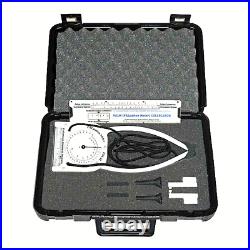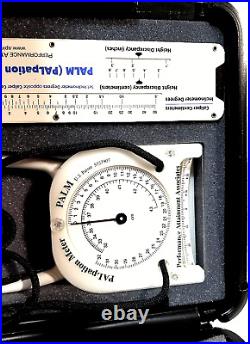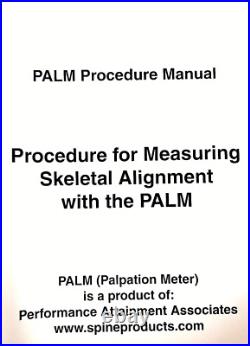Palpation Meter (PALM) for Skeletal Alignment Evaluation. MFID PALM








Palpation Meter (PALM) for Skeletal Alignment Evaluation. The Objective Way to Perform Skeletal Alignment Evaluations. The PALM combines the ease and proprioceptive advantages of palpation with the objectivity and reliability of caliper and inclinometer measurements. The caliper determines the distance in centimeters between the two palpating fingers.
The inclinometer determines the inclination in degrees between the two palpating fingers. A unique slide rule calculator gives you the height discrepancy between the two landmarks palpated in both centimeters and inches. Differentiating between a Functional and a Structural Short Leg. The PALM will help you differentiate what part of the leg length inequality is structural and what part is functional.
Measurement of the iliac crest heights in the standing position determines if there is a relative height difference. Measurement of the iliac crest's relative heights in the seated position removes height discrepancies due to lower extremity asymmetrics. Determining height discrepancies at landmarks.
The PALM allows you to determine skeletal asymmetry and then locate the point of asymmetry by making measurements at various landmarks like: Medial Malleoli, Fibular Heads, AC Joints, Mastoid Processes, Gluteal Folds. One of three types of palpation tips can be selected depending on the shape and location of landmarks. Pointed tips for palpation of visual landmarks or marks applied to the skin.
L tips for palpation of bony ledges. O tips for palpation of landmarks directly with finger tips. PALM PALpation Meter for Measuring Skeletal Alignment, Leg Length Discrepancy. The PALM PALpation Meter is used by therapists and researchers for measuring a patient's skeletal alignment and assessment of LLD.The PALM PALPation meter utilizes the simplicity and proprioceptive benefits of palpation along with the objective precision of caliper and inclinometer measurements. This device uses a caliper to determine the distance in centimeters between two palpating fingers, and an inclinometer that displays the inclination in degrees between the two palpating fingers. The PALPation device includes unique slide rule calculator to allow therapists to read the height discrepancy between the two landmarks palpated in both centimeters and inches. The PALM gears (for the caliper) are made in a die mold so each gear is exactly the same.
The PALM is assembled according to an exact written protocol and each PALM is hand tested on a template for accuracy. The vial which measures the inclination is cemented in place and then tested on a template before it is put in a case. If either the meter or caliper is off it is recalibrated by hand and retested. Typical Use Differentiating between a Functional and a Structural Short Leg. Other Uses Determining height discrepancies at landmarks.
The PALM allows you to determine skeletal asymmetry and then locate the point of asymmetry by making measurements at various landmarks like. The PALM Caliper can also determine chest cavity expansion and absolute bone length. The PALM is easy to use because the large caliper dial makes length measurements easy and the fluid damped inclinometer allows quick and accurate angle measurements. The caliper on the PALM measures 0 - 43 cm and the inclinometer measures from 0-30 degrees in the horizontal plane (only).